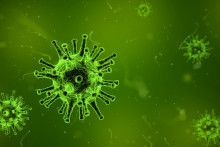Huskens began the large-scale research on ‘the flu virus’ at MESA+ three years ago. ‘Every flu season there is a new virus. It mutates at much higher rates than normal organisms,’ says the professor of Supramolecular Chemistry & Nanotechnology. ‘The virus can even “learn” to infect different species, jumping from animals to humans, which can lead to a pandemic. How does it do that? Can we predict what will happen by studying the mutations and their effect on the binding of the virus to a cell surface? Those are the questions we address.’
Binding mechanisms
‘Flu infection occurs because the proteins on the outside of a virus attach themselves to the sugars on the cell membrane of animals or humans,’ explains the scientist. ‘We don’t understand on what molecular interactions these bindings depend.’ Understanding these binding mechanisms is precisely what Huskens and his team want to accomplish within the project. Their paper ‘Weak Multivalent Binding of Influenza Hemagglutinin Nanoparticles at a Sialoglycan-Functionalized Supported Lipid Bilayer’ describes the very first results and breakthroughs.
‘We have overcome one major hurdle: creating a chemical platform where we can observe the binding properties in a quantitative manner,’ Huskens highlights the main findings presented in the paper. ‘This is a completely new system that allows us to study the virus binding. We use a model particle with only the binding protein, and we can see exactly how many interactions are involved when the cell surface comes into contact with the virus particle. Thanks to this, we can, for example, compare the surfaces of human cells and bird cells to see what the virus prefers and try to figure out why.’
Predicting mutations
The next step is using the chemical platform to study different flu viruses and mutations. ‘There is a big difference in the binding even if there is only a very small mutation,’ says the researcher. ‘Understanding the molecular binding properties will hopefully allow us to answer why and how viruses mutate and, consequently, allow us to predict these mutations. The knowledge we are developing can also help design better antiviral drugs.’ Some of these answers should be available in two years, when the research project is officially finished. However, as Jurriaan Huskens points out: ‘Science is rarely finished. New questions always arise.’







